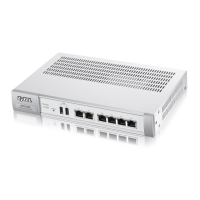Chapter 15 Captive Portal
NXC Series User’s Guide
225
The following table describes the labels in this screen.
Table 101 Configuration > Captive Portal > Redirect on AP: Auth. Policy Add/Edit
LABEL DESCRIPTION
Create New
Object
Select an object (SSID Profile, Address or Schedule) from the list to create a new one. You can
then use the object with the authentication policy rule. For example, if you create a new
address object called ‘CoffeeBar’, then you can select it immediately from the Source Address
list or the Destination Address list in this screen.
General Settings
Enable Policy Select this to enable the new authentication policy. You can later edit the authentication
policy and deselect it if you want to disable it.
Theme Name Enter a name for this policy. You can use up to 31 alphanumeric characters. Dashes and
underscores are also allowed. The name should start with a letter.
Description Enter an optional description of the authentication policy. You can enter up to 60 characters.
User Auth Policy
SSID Select a pre-defined SSID profile to which the policy is applied.
Note: You cannot select and apply the policy to an SSID profile in Tunnel forwarding
mode.
Source Address Select an address object from the list. If none are available, you can create a new one using
the Create New Object button.
The source address is an IP address for which the captive portal intercepts all network traffic.
Destination
Address
Select an address object from the list. If none are available, you can create a new one using
the Create New Object button.
The destination address is an IP address for which the captive portal intercepts all network
traffic toward.
Schedule Select a schedule from the list. If none are available, you can create one in Configuration >
Object > Schedule.
Authentication Select whether authentication is required or not necessary for this rule.
Authentication
Method
Select an authentication method for the captive portal page. You can configure the
authentication method in the Configuration > Object > Auth. Method screen (Chapter 26 on
page 313).
This field is not available if you select No Authentication under Authentication Type.
Authentication Type
Internal Web
Portal
Select this to use the login page built into the NXC.
The login page appears whenever the web portal intercepts network traffic, preventing
unauthorized users from gaining access to the network.
Portal Theme Select a login page theme that you created or uploaded using the Custom Captive Portal
screen.
External Web
Portal
Select this to use a custom login page from an external web portal instead of the one built into
the NXC. You can configure the look and feel of the web portal page.
Note: It is recommended to have the external web server on the same subnet as the
login users.
Login URL Specify the login page’s URL; for example, http://IIS server IP Address/login.html. You must
configure this field if you select External Web Portal.
The Internet Information Server (IIS) is the web server on which the web portal files are installed.
Logout URL Specify the logout page’s URL; for example, http://IIS server IP Address/logout.html.
The Internet Information Server (IIS) is the web server on which the web portal files are installed.

